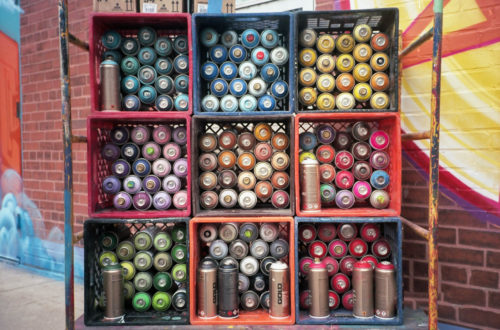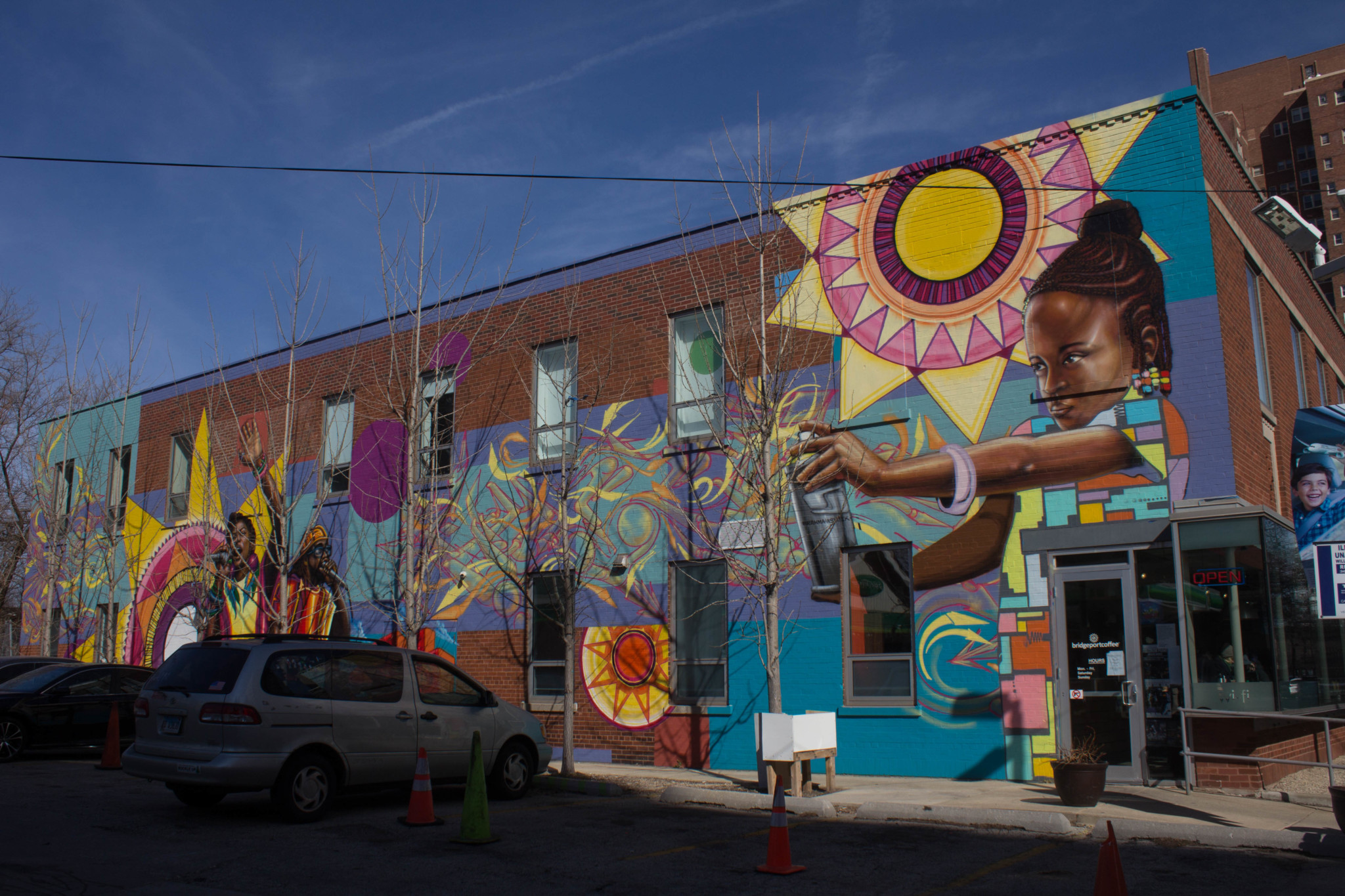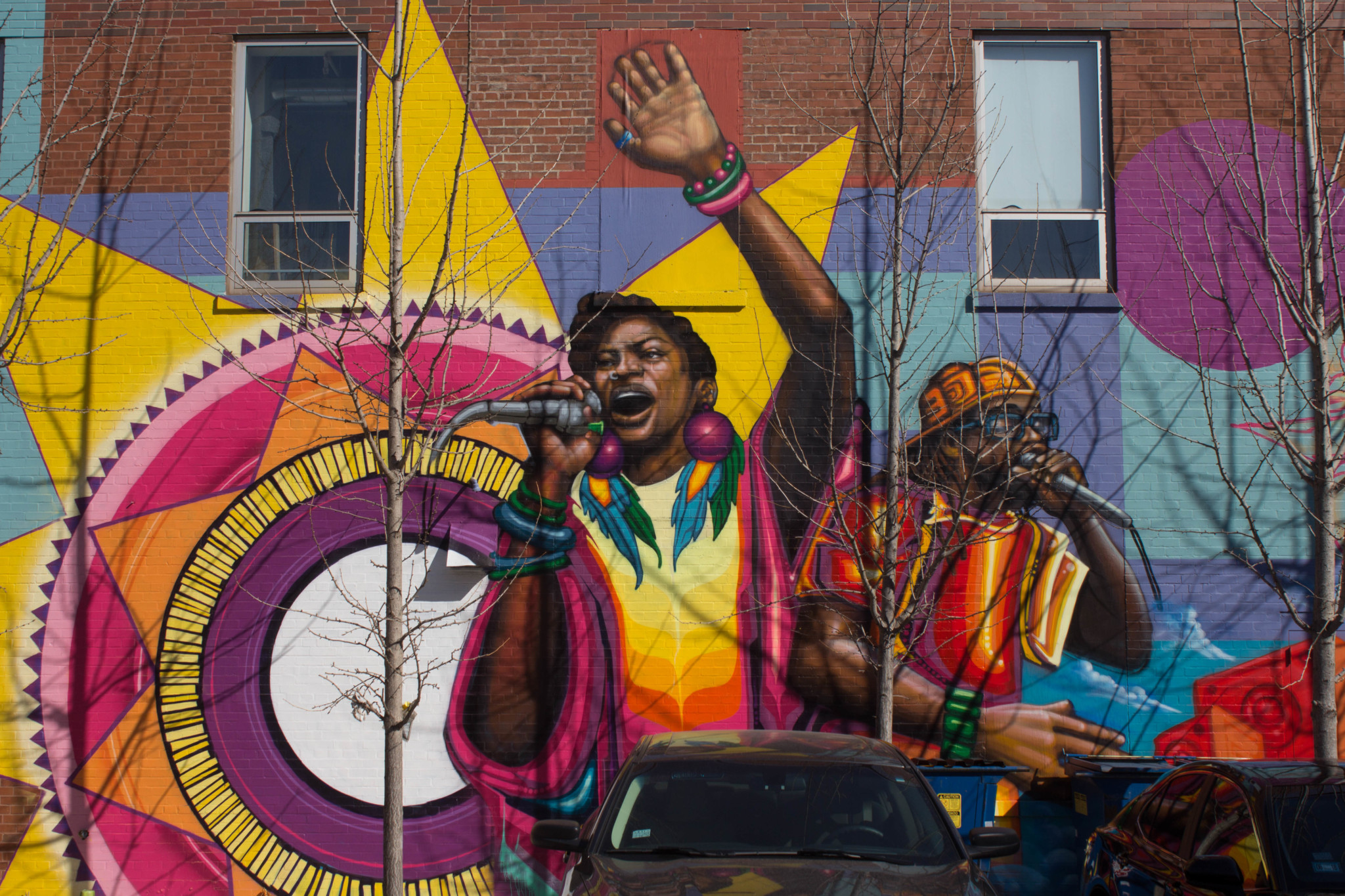If you take a ride on the Jackson Park Express bus—going either way on Hyde Park Boulevard past Cornell Avenue—you’ll catch a glimpse of a relatively new, large-scale mural on the south wall of the Hyde Park Art Center (HPAC).
This mural, “Children of the Wall,” is an ode to the fiftieth anniversary of the “Wall of Respect,” an iconic mural that honored more than fifty African American heroes. “Children of the Wall” was organized by graffiti artists Liz Lazdins (also known as Beloved), Miguel Aguilar (Kane One), Rahmaan Barnes (Statik), and Lavie Raven (Raven).

The “Wall of Respect” was created in 1967 by artists and photographers that were part of the Organization of Black American Culture (OBAC). Located on a two-story tavern at 43rd and Langley in Grand Boulevard, the wall served as a symbol of Black excellence and a representation of the heroes and heroines of African American history. More than fifteen artists, photographers, and designers came together to collaborate on this project, painting portraits of important political leaders, musicians, athletes, and writers such as Malcolm X, Bill Russell, Muhammad Ali, and W.E.B. Du Bois.
Mural artist and organizer Rahmaan Barnes, also known as Statik, told the Weekly that the “Children of the Wall” mural was created from ideas similar to the “Wall of Respect,” but was never meant to be a direct imitation. The mural incorporates important local hip-hop artists and groups, with Brickheadz breakdancers and Kuumba Lynx as its main subjects. It also includes various graffiti-inspired designs, geometric shapes, and vibrant colors. Each of the artists added their own flair to the mural.
Statik contributed three different characters to the wall—to the right, a young girl is depicted using spray-paint, flowing into a swarm of arrows painted by Lavie Raven. To the left, two emcees with mics are performing side-by-side, painted on top of organizer and artist Liz Lazdins’s characteristic geometrical designs resembling the sun.
Support community journalism by donating to South Side Weekly
Statik describes himself as an illustrative mural artist, commercial artist, and street artist from the South Side of Chicago, east of the Dan Ryan. He started painting on walls when around sixteen years old. After a run-in with the police over vandalism in Hyde Park as a young artist, he devoted himself to bringing graffiti art into the light of day by matching the aesthetic of graffiti with public murals. Statik says he made a pact with his crewmember Max Sansing to “paint [more] walls than your average illegal graffiti writer bombed and tagged.”
Much of the work Statik creates parallels the ideas behind the “Children of the Wall” mural. Statik told the Weekly that Black representation and the reversal of negative stereotypes is important because it can change the way a community looks at itself. The emcees he painted help to defy the stereotype that Black men and women have an inability to work together or be productive. He says that authentic representation “combats the argument that the only thing that comes from the South Side is the high homicide and high murder rate. A lot of great minds and artists alike have come from these areas that the rest of the world considers as a warzone.”
The “Wall of Respect” was an important contribution to Black culture in Chicago and beyond because it reflected the important Black artists and activists of its time. The “Children of the Wall” mural seeks to serve a similar purpose: to put a mirror to South Side residents as a way of reflecting the beauty that already exists within their communities. Statik says that he and the other commissioned artists wanted to emphasize of the idea of painting local community members as heroes. The importance of this mural lies with its ability to almost act as a mirror to the community, to reflect the beauty in the people that live there and have lived there for years.

Prior to starting the project, the artists asked young people on social media and in person who their everyday superheroes were. Many people listed activists, artists, family members, teachers, and Black and brown friends as their heroes. These responses were used to give lead artists direction as to who should be depicted on the wall and what ideas should be centralized.
In addition to the mural painting, a Graffiti Jam and an artist talk was held. The Graffiti Jam event invited community members to the wall to see its progress and communicate with the artists and organizers, just as the “Wall of Respect” had a dedication where poets Haki Madhubuti and Gwendolyn Brooks read poems to commemorate the wall’s influence. The “Children of the Walls’” Graffiti Jam included rappers, poets, live graffiti painting, food, and community art projects. While lead artist Miguel Aguilar painted the phrase “The Vibes are Back” on the metal garage doors, local musicians and community groups such as Kuumba Lynx, IMAN, Stick and Move Youth Crew, University of Hip-Hop, and Urbanized Music performed. Local artists Bel2, Dwel, and Stef painted on mobile canvas, and delicious grilled food was served to hungry audience members.
Although the “Wall of Respect” only lasted until 1971, due to a mysterious fire that broke out in the building the mural was painted on, the wall’s impact reached communities in and beyond Chicago, becoming a catalyst for mural art in Black communities. The artists behind “Children of the Wall” hope to have a similar impact by inspiring the current generation to use ideas explored by the “Wall of Respect” and “Children of the Wall” to create their own catalysts for representation within communities of color.
Rod Sawyer is the Weekly’s visual arts editor. He last wrote for the Weekly about the Blackstone Branch Library’s archives in December.

